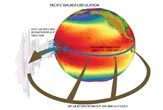
The trade winds in the Pacific Ocean are weakening as a result of global warming, according to a new study that indicates changes to the region's biology are possible.
Using a combination of real-world observations and computer modeling, researchers conclude that a vast loop of circulating wind over the Pacific Ocean, known as the Walker circulation, has weakened by about 3.5 percent since the mid-1800s. The trade winds are the portion of the Walker circulation that blow across the ocean surface.
The researchers predict another 10 percent decrease by the end of the 21st century.
The effect, attributed at least in part to human-induced climate change, could disrupt food chains and reduce the biological productivity of the Pacific Ocean, scientists said.
The study was led by Gabriel Vecchi of the University Corporation for Atmospheric Research and is detailed in the May 4 issue of the journal Nature.
Humans to blame
The researchers used records of sea-level atmospheric pressure readings from as far back as the mid-1800s to reconstruct the wind intensity of the Walker circulation over the past 150 years. A computer climate model replicated the effect seen in the historical record.
Get the world’s most fascinating discoveries delivered straight to your inbox.
Some of the computer simulations included the effects of human greenhouse gas emissions; others included only natural factors known to affect climate such as volcanic eruptions and solar variations.
"We were able to ask 'What if humans hadn't done anything? Or what if volcanoes erupted? Or if the sun hadn't varied?'" Vecchi said. "Our only way to account for the observed changes is through the impact of human activity, and principally from greenhouse gases from fossil fuel burning."
Earth's average temperature has risen by about 1 degree Fahrenheit over the past century and many scientists believe greenhouse gases and carbon dioxide emissions from human activities are to blame.
"This is evidence supporting global warming and also evidence of our ability to make reasonable predictions of at least the large scale changes that we should expect from global warming," Vecchi told LiveScience.
By extrapolating their data and combining it with results from other models, the researchers predict the Walker circulation could slow by an additional 10 percent by 2100.
Driving force
The trade winds blow from the east at an angle towards the equator and have been used by sailors for centuries seeking to sail west. Christopher Columbus relied on the Atlantic's trade winds to carry him to North America. The winds get their name from their reliability: To say that a "wind blows trade" is to say that it blows on track.
The overall Walker circulation is powered by warm, rising air in the west Pacific Ocean and sinking cool air in the eastern Pacific.
This looping conveyer belt of winds has far-reaching effects on climate around the globe. It steers ocean currents and nourishes marine life across the equatorial Pacific and off the coast of South America by driving the upwelling of nutrient-rich cold water from ocean depths to the surface.
The Walker circulation is also primarily responsible for transporting water vapor that evaporates from the ocean surface west, towards Indonesia; there, the moisture rises up into the atmosphere, condenses, and falls back to Earth as rain.
The effects of global warming
Several theories on the effects of global warming predict a weakening of the Walker circulation. Scientists think it works like this:
To remain energetically balanced, the rate at which the atmosphere absorbs water vapor must be balanced by the rate of rainfall. But as temperatures rise and more water evaporates from the ocean, water vapor in the lower atmosphere increases rapidly. Because of various physical processes, however, the rate of rainfall does not increase as fast.
Since the atmosphere is absorbing moisture faster than it can dump it, and because wind is the major transporter of moisture into the atmosphere, air circulation must slow down if the energy balance is to be maintained.
A drop in winds could reduce the strength of both surface and subsurface ocean currents and dampen cold water upwelling at the equator.
"This could have important effects on ocean ecosystems," Vecchi said. "The ocean currents driven by the trade winds supply vital nutrients to near-surface ocean ecosystems across the equatorial Pacific, which is a major fishing region."
- VIDEO: The End of the Earth
- El Nino Now Blamed for Practically Everything
- Global Warming May Play Role in Hurricane Intensity
- Conflicting Claims on Global Warming and Why It's All Moot
- Natural Disasters: Top 10 U.S. Threats
Hot Topic
The Controversy
- Global Warming Differences Resolved
- Conflicting Claims on Global Warming and Why It's All Moot
- Baffled Scientists Say Less Sunlight Reaching Earth
- Scientists Clueless over Sun's Effect on Earth
- Greenhouse Gas Hits Record High
- Key Argument for Global Warming Critics Evaporates
The Effects
- Seas to Rise
- Greenland Melts
- Ground Collapses
- Glaciers Disappear
- Allergies Get Worse
- Rivers Melt Sooner in Spring
- Increased Plant Production
- Animals Change Behavior
- Hurricanes Get Stronger
- Lakes Disappear
The Possibilities
- More Rain but Less Water
- Ice-Free Arctic Summers
- Overwhelmed Storm Drains
- Worst Mass Extinction Ever
- A Chilled Planet
Strange Solutions


